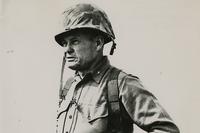Air Force Lt. Col. Gerald Young was not the first helicopter pilot to risk his life in combat, but he was the first of such men to receive the Medal of Honor. Young's heroics during a mission-gone-wrong over the jungles of Vietnam helped save several stranded comrades who were directly in the path of enemy fighters.
Young was born on May 19, 1930, in Chicago, just as the Great Depression was taking hold. He grew up during the World War II era, so by the time he was 17, he enlisted in the Navy to do his part to serve. Young was discharged in 1952, but after a few years back in civilian life, he reenlisted in 1955. He served in the Navy for another year before being accepted into the Air Force aviation cadet training program, from which he earned his commission in 1958.
Over the next decade, Young served in several locations, including Japan and for missions that supported the atomic tests taking place in the Marshall Islands.
By 1967, the war in Vietnam was in full effect. Young deployed to the country as a rescue helicopter pilot with the 37th Air Rescue Service based at Da Nang Air Force Base. He was 37 and on his 60th combat mission as the pilot of an HH-3E Jolly Green Giant when he earned the Medal of Honor.
In the early-morning hours of Nov. 9, 1967, then-Capt. Young's helicopter was part of a five-aircraft team sent to rescue a U.S./South Vietnamese Army ground reconnaissance team that was surrounded in the jungle near Khe Sanh. Two other choppers that had tried to rescue them earlier were taken out by ground fire from the enemy.
The Army team was stuck on the side of a steep slope, which required some special maneuvering to reach them. Young's helicopter was backing up another chopper that managed to pick up three of the survivors before being heavily damaged by enemy fire. As that pilot pulled away, he advised Young to abandon the rescue of the last survivors because the gunfire was impossible to evade. Other helicopter gunships that were supporting them were also reportedly low on fuel and ordnance.
Instead of escorting the damaged helicopter to safety, Young and his crew tried to finish the mission. Young dropped his helicopter down to the survivors, hovering with only one wheel on the ground so the rotors wouldn't touch the hillside. The last of the survivors boarded the aircraft before enemy fighters on the ground closed in.
As Young prepared for takeoff, those insurgents raked the aircraft with gunfire and grenades at point-blank range. One of the helicopter's engines exploded. The chopper flipped, burst into flames and fell down the hill.

Young, who was suspended in the cockpit by his seat belt, managed to kick out a window of the burning fuselage and rolled down the hill. When he stopped, he frantically put out the fire still on his clothes and parachute.
Young was seriously burned, but he ignored his own injuries to tend to an unconscious man who had been thrown from the chopper. He hid that man in some underbrush. Young then tried to get back to the helicopter, but the heat and gunfire were too intense.
By dawn, Young had made his way to a clearing and had managed to use flares and radio signals to let searching aircraft know where he was. But he also knew hostile forces were using him as bait to draw in more helicopters, so he refused their rescue.
During a lull in enemy fire, rescue crews collected a few more crash survivors. But as enemy forces returned and closed in on Young's crash scene to find him, he led them in the opposite direction to take the pressure off more rescue forces.
For the rest of the day, despite the intense pain from his burns, Young hid in dense foliage as the North Vietnamese pursued him. This gave other rescue crews time to land at the crash site and collect survivors and those who had died.
After 17 hours, Young had wandered six miles from the crash site and finally evaded his pursuers long enough to call another rescue helicopter. That chopper extricated him from his precarious position.
When he returned to the United States, Young spent three months in a hospital to recover from the burns that blistered more than a quarter of his body.
A few months later, on May 14, 1968, he received the Medal of Honor from President Lyndon B. Johnson during a ceremony at the White House.
Young continued his career in the military and earned a bachelor's degree from the University of Maryland while he was stationed in Washington, D.C. He met his wife, Yadi, during a trip to Costa Rica. They were married in 1972 and had a daughter they named Melody.
Young retired in 1980 at the rank of lieutenant colonel. He and his wife moved to a 30-acre farm in Anacortes, Washington, where Young spent the next decade speaking about his military career to students, ROTC units and at public events.
Young died on June 6, 1990, of a brain tumor. He was buried in Arlington National Cemetery with full military honors. The town of Anacortes dedicated a park in his honor.
Want to Learn More About Military Life?
Whether you're thinking of joining the military, looking for post-military careers or keeping up with military life and benefits, Military.com has you covered. Subscribe to Military.com to have military news, updates and resources delivered directly to your inbox.














